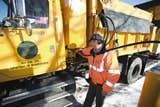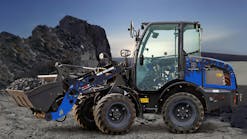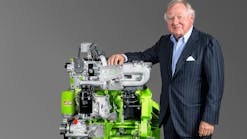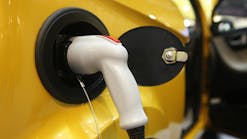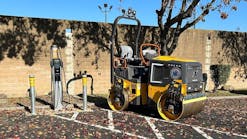Joseph Darling Director of Fleet Administration & Support
Headquarters: Albany, NY
Specialties: State public works, snow and ice removal, alternative energy
Equipment Value: $300 million
Fleet Makeup: 13,000-plus vehicles ranging from compact sedans, pick-ups, vans and utility vehicles to special-purpose vehicles for road maintenance and construction, snow and ice removal, and asset tracking
Support Staff: 450 mechanics, parts room staff, supervisors, and clerical and administrative staff
Market Range: Entire of New York State, supporting a 110,000-mile state and local highway system, including 17,000 bridges
Joseph Darling knows his plan to convert the New York State Department of Transportation's fleet to natural gas is a winner.
"Because natural gas is such a clean-burning fuel," says Darling, the department's director of fleet administration and support, "our oil changes have been extended out about 2-1/2 times on the light-duty fleet."
Vehicles for which oil changes were recommended at 4,000 miles are now having the service done at 10,000 miles, "and from some of the oil sampling we've got, we're still changing clean oil."
According to a five-year analysis conducted by Darling back in 2003, the department's compact sedans powered by compressed natural gas (CNG) averaged a cost-per-mile of 3 cents, compared to 8 cents for those powered by gas. For pick-up trucks and vans, the CNG vehicles cost 6.9 cents per mile, compared to 14.5 cents per mile for gas-powered units.
"Some of this was due to fuel cost savings, but not all of it," he reported.
When wear parts were disassembled, there was evidence of less carbon build-up, thus less friction.
NYDOT switched to an entirely new information system in late 2004, and the data compiled since on the newer vehicles is "rather insignificant" at this stage. But the evidence has long been clear to Darling.
"At that time, we were saving 20 to 50 cents per gallon on fuel costs, but recently we have experienced savings of over $1 per gallon," he reported this winter.
"Right now, it is costing $1.33 for CNG at our facilities versus $1.83 for gasoline and $2.16 for winter-mix diesel fuel."
To that point, the winter had been mild in the Northeast, so diesel prices had not escalated as much as often is the case, when heating oil demand is higher. In the summer, gas prices will rise and diesel prices will subside.
The drawback to CNG is the cost of the supply and storage infrastructure required to service the fleet, "but if you figure in the remediation and liability costs associated with a gasoline or diesel fuel tank replacement, the overall costs to own a CNG facility is lower."
Furthermore, the liquefied natural gas (LNG) option that would best serve the heavy-duty fleet would help lower facility costs, said Darling. The compressor is replaced, which lowers the operational and maintenance expenditures, while capital costs remain the same, he said.
What's holding New York State back from full fleet implementation of natural gas fuel is a state-wide legislative moratorium placed on LNG following a fatal industrial accident on Staten Island in 1976. The accident was the result of a welding mishap unrelated to LNG itself, but happened to take place in an LNG facility, said Darling.
CNG has limitations not unlike hydrogen — another alternate fuel that is garnering support.
"In a gaseous state, it is hard to store enough natural gas on board for an over-the-road trucking operation or for any long-distance operation involving multiple hours out on a job without refueling capacity," said Darling.
"With liquefied natural gas, you get more volume in the same area, which addresses a lot of range limitations that are associated with compressed natural gas. It also comes from a lot of renewable sources, so there's a renewable benefit there."
By taking methane from such readily available sources as landfills and wastewater-treatment plants, "you can create an enormous amount of liquefied natural gas to displace our use of petroleum fuels.
"Most states in the country could move toward LNG right now," he said. "It would be a benefit to them, because a lot of states don't have pipeline capacity like we do in New York State. With LNG, you can liquefy it and ship it in a cryogenic tanker and store it on site, and either dispense it as a liquid or vaporize it into compressed natural gas, whichever way you decide to use it."
Besides the 800 light-duty vehicles utilizing CNG, NYDOT did retrofit 35 heavy-duty snowplows to "what we call dual fuel. They're standard diesel engines that are compression ignition. They start as a pilot on diesel fuel, and through electronics, they convert over to natural gas at about an 80/20 mixture, so you're still using some diesel fuel for lubrication, but most of the fuel is displaced with natural gas."
In terms of vehicle performance, the use of CNG poses no disadvantage. Besides the volume limitations, a drawback for full use is the requirement for steel tanks that naturally increases vehicle weight.
"We've built 58 natural-gas fueling facilities across New York State. I have about 200 fuel facilities within DOT across the state, so that's only about a quarter of my total capacity," said Darling, based in the state capitol of Albany.
Built in a three- to four-year span, the 58 facilities mean that CNG is available for light-duty fleet use and limited heavy-duty fleet use pretty well from one end of the state to the other.
"The key for full implementation across the entire fleet is for the LNG," said Darling, "so that we can go to those other 150 sites — because they're not convenient to pipelines — and build LNG storage facilities there."
While state legislation is delaying full implementation of natural-gas use in DOT vehicles today, it was a state government initiative that actually got the ball rolling on natural gas use.
With his state designated as non-compliant of EPAct standards, Governor George Pataki created in 1997 a Clean Fuel Vehicle Council with the express desire to implement alternate fuels in the state's fleet. The council considered various alternate fuels, including biofuels, hybrids, electric, methanol and natural gas.
"From the information that was available then, we decided that natural gas presented the best opportunity for application to not only the light-duty fleet, which was covered under EPAct, but also to transition to the heavy-duty and construction fleet, which is a big part of DOT's responsibility," said Darling. "Since we're the biggest fleet on the Clean Fuel Vehicle Council, our perspectives were given a lot of consideration."
